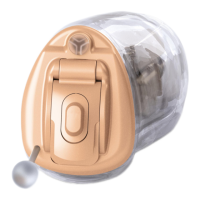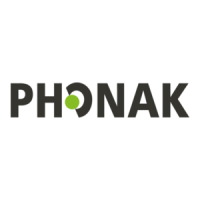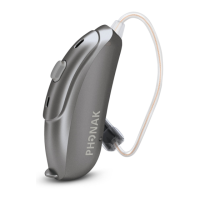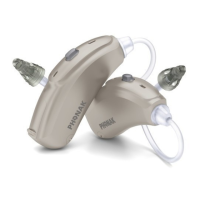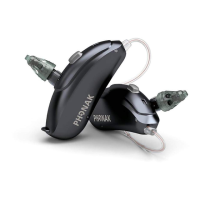Do you have a question about the Phonak Virto V50 and is the answer not in the manual?
Identifies left and right hearing aids by color markings.
Step-by-step instructions for replacing hearing aid batteries.
Guidance on operating the hearing aid's power, push button, and volume.
Diagram illustrating the components of the Virto V-10 hearing aid.
Diagram showing parts of Virto V-nano, V-10 O, and V-10 NW 0 models.
Illustration of the Virto V-312 hearing aid components.
Diagram detailing the parts of the Virto V-13 hearing aid.
Information on selecting and using the correct zinc-air batteries for your hearing aid.
Procedure for removing the hearing aid using its removal handle.
Advice on protecting the hearing aid from damage by cosmetics, heat, and moisture.
Daily cleaning recommendations and advice on wax guard systems.
Guidance for more in-depth cleaning and maintenance procedures.
Explanation of SmartGuard and Cerustop wax protection systems.
Overview of Phonak accessories for connecting to various audio devices.
Benefits of Roger portfolio for understanding speech in noisy environments.
Information on obtaining warranty terms from the hearing care professional.
Details of Phonak's one-year limited international warranty.
Phonak AG declares product conformity with EU directives.
Supplier Code Number for Australia.
Supplier Code Number for New Zealand.
Certification details for various Phonak Virto V wireless models.
Important notices regarding FCC and IC compliance for wireless models.
Meaning of the CE symbol indicating conformity with EU directives.
Indicates adherence to EN 60601-1 requirements for applied parts.
Symbol indicating the medical device manufacturer as per EU directive.
Symbols for regulatory compliance, user guidance, and warnings.
Information on operating conditions, temperature, humidity, and disposal.
Solutions for hearing aid not functioning, whistling, or intermittent power.
Addressing issues with low volume or distorted sound output.
Interpreting and responding to hearing aid beep indicators.
Key warnings and precautions for safe use of the hearing aid.
Awareness of directional mode limitations and child safety warnings.
Guidelines for connecting devices and precautions for medical implants.
General advice on protecting the hearing aid from water, heat, and dropping.
Advice for dispensers regarding medical evaluations for prospective users.
List of medical conditions that necessitate consultation before hearing aid fitting.
Recommendations for prospective users regarding medical evaluations and fitting.
Advice on discontinuing use and seeking medical evaluation for side effects.
Information on OSHA regulations concerning noise generator volume and hearing damage.
Identifies left and right hearing aids by color markings.
Step-by-step instructions for replacing hearing aid batteries.
Guidance on operating the hearing aid's power, push button, and volume.
Diagram illustrating the components of the Virto V-10 hearing aid.
Diagram showing parts of Virto V-nano, V-10 O, and V-10 NW 0 models.
Illustration of the Virto V-312 hearing aid components.
Diagram detailing the parts of the Virto V-13 hearing aid.
Information on selecting and using the correct zinc-air batteries for your hearing aid.
Procedure for removing the hearing aid using its removal handle.
Advice on protecting the hearing aid from damage by cosmetics, heat, and moisture.
Daily cleaning recommendations and advice on wax guard systems.
Guidance for more in-depth cleaning and maintenance procedures.
Explanation of SmartGuard and Cerustop wax protection systems.
Overview of Phonak accessories for connecting to various audio devices.
Benefits of Roger portfolio for understanding speech in noisy environments.
Information on obtaining warranty terms from the hearing care professional.
Details of Phonak's one-year limited international warranty.
Phonak AG declares product conformity with EU directives.
Supplier Code Number for Australia.
Supplier Code Number for New Zealand.
Certification details for various Phonak Virto V wireless models.
Important notices regarding FCC and IC compliance for wireless models.
Meaning of the CE symbol indicating conformity with EU directives.
Indicates adherence to EN 60601-1 requirements for applied parts.
Symbol indicating the medical device manufacturer as per EU directive.
Symbols for regulatory compliance, user guidance, and warnings.
Information on operating conditions, temperature, humidity, and disposal.
Solutions for hearing aid not functioning, whistling, or intermittent power.
Addressing issues with low volume or distorted sound output.
Interpreting and responding to hearing aid beep indicators.
Key warnings and precautions for safe use of the hearing aid.
Awareness of directional mode limitations and child safety warnings.
Guidelines for connecting devices and precautions for medical implants.
General advice on protecting the hearing aid from water, heat, and dropping.
Advice for dispensers regarding medical evaluations for prospective users.
List of medical conditions that necessitate consultation before hearing aid fitting.
Recommendations for prospective users regarding medical evaluations and fitting.
Advice on discontinuing use and seeking medical evaluation for side effects.
Information on OSHA regulations concerning noise generator volume and hearing damage.
| Type | Hearing Aid |
|---|---|
| Product Line | Virto |
| Model | V50 |
| Style | Custom In-The-Ear (ITE) |
| Noise Reduction | Yes |
| Feedback Management | Yes |
| Microphone | Directional |
| Rechargeable Option | No |
| Battery Type | Size 312 |
| Tinnitus Features | Yes |
